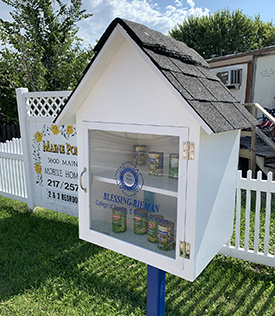Blessing-Rieman College of Nursing & Health Sciences students develop and sharpen their patient care skills using exceptional technology in the College’s Simulation Lab.
But the latest addition to the college’s teaching tool belt is not found in that high-tech lab. In fact, this new item is “no-tech.” It’s a wooden and glass box sitting on top of a painted, steel pole, anchored in a cement foundation. It stands in front of the mobile home park at 36th and Maine streets on Quincy’s east side. Its purpose is as important to the education of student nurses as the lessons learned in the Simulation Lab.
It’s called the Blessing Box - a community food donation and distribution site - a place where people facing hunger find donated non-perishable food items.
How the Blessing Box came to be
 During the pandemic, students of Blessing-Rieman’s Community Health Nursing class identified a lack of food-related assistance on Quincy’s east side. Together students, faculty and staff developed a remedy for the situation.
During the pandemic, students of Blessing-Rieman’s Community Health Nursing class identified a lack of food-related assistance on Quincy’s east side. Together students, faculty and staff developed a remedy for the situation.
The idea for the Blessing Box was born.
“Compassion,” said Brenda Beshears, PhD, RN, college president and chief executive officer, about what the Blessing Box is teaching nursing students. “We learn compassion by experiencing and participating in different activities.”
Three Quincy businesses joined the effort to develop the finished product – Plant Creative Wood Design, Michelmann Steel and Quincy Industrial Painting. Blessing Hospital’s Construction Department installed the Blessing Box.
“It’s part of the teamwork we have here at Blessing-Rieman all the time,” said Lila Warning, MSN, RN, CNE, assistant professor. “One person has a great idea and we all jump on board to help out.” Lila helped identify and secure the location where the Blessing Box stands.
Since its installation in late June, the Blessing Box has been very busy. While anyone is welcome to place donations in the box – and have been doing so – students in Blessing-Rieman’s Community Health Nursing class own the responsibility for ensuring the box remains full. Erika Knuffman, MSN, RN, CNE, instructor, says the experience will shape the way Blessing-Rieman educated nurses see those for whom they care for the rest of their careers.
“Every person has a story,” said Erika. “Once you hear that story and try to understand, it lets a wall down and you see the other person as a human. It’s part of building empathy and understanding, respect and dignity when you try to understand another person’s story.”
The Blessing Box satisfies more than hunger
The Blessing Box has touched everyone involved in the project. Tyler Plant is a Blessing-Rieman graduate, Blessing Hospital nurse, and owner of Plant Creative Wood Design. He made the Blessing Box.
“I love giving back to the community that has helped me succeed in all aspects of my life,” said Tyler. “I thoroughly enjoy giving back, and it comes with a great deal of satisfaction.”
And when the Blessing Construction Department was finished installing the Blessing Box, they made sure to fill it - at their own expense - before heading back to the hospital.
“Our team filled the Blessing Box because Blessing Health System has provided us with great jobs that we all love,” said Nathan Childress, CHC, Blessing Construction manager. “Construction team members understand how fortunate we are to be in a position to provide a hand up to others.”
“We want to give back in more ways than just education,” concluded Dr. Beshears about the Blessing Box project. “We want to be a contributing member of our community.”
The numbers behind the need
According to census.gov, the July 1, 2021 estimated population for Quincy is 39,131 people, of which 15.3% are living in poverty. That equates to roughly 5,870 individuals who are living at or below the federal poverty line standards. https://www.census.gov/quickfacts/quincycityillinois
Poverty guidelines are defined as median household income of an individual earning $12,880/year, For a family of 4, $26, 500/year.
Food insecurity affects 10.5 % of US households. https://www.ers.usda.gov/topics/food-nutrition-assistance/food-security-in-the-u-s/key-statistics-graphics/#foodsecure
